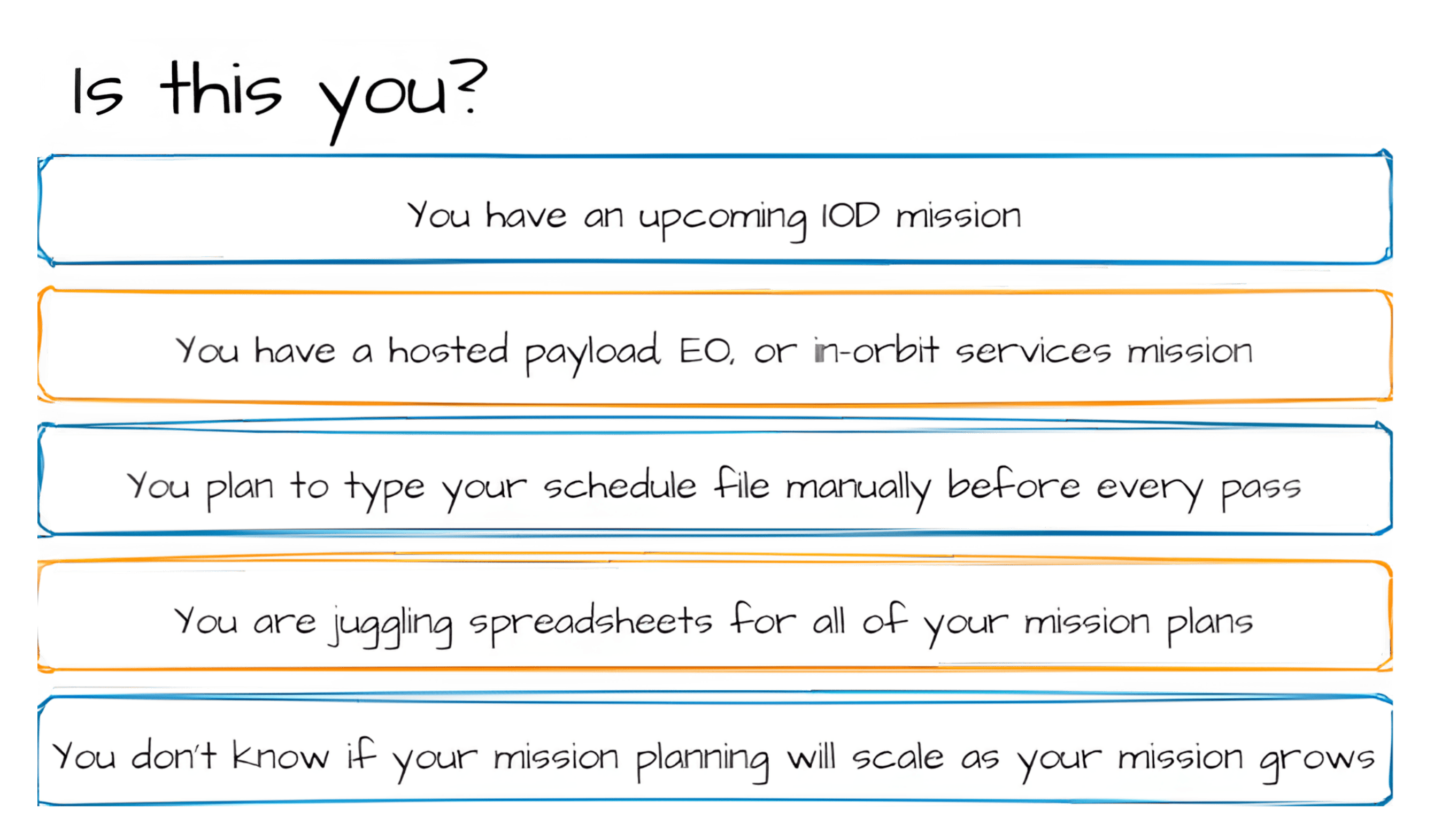Introduction
Mission planning and scheduling systems, also known as a Mission Planning System (MPS), are at the heart of satellite operations, orchestrating the complex dance of tasks, resources, and constraints necessary for your mission success.
Making the choice of which MPS to use in your mission is complex – because it’s not just a choice that affects your operations today, it will also influence how your organization functions in the future.
In an ideal world, the right MPS will harmonize with your existing systems, creating an overall stronger stack. It needs to be easy for your team to onboard with, and doesn’t get in the way of you expanding its capabilities.

Pressures to find the right fit
Operators nearing their launch or post-launch phase can face a lot of pressure to find an appropriate MPS for their mission. This is a difficult thing to do because not every off-the-shelf solution can meet all of their needs, which leads to decision-makers having to make tradeoffs to find the best solution.
If you’re in a similar situation, you may be asking yourself the question: How much development time is an MPS going to cost me and my team? In the US, a 3-person development team starting from scratch can cost upwards of $750K/year. On the other hand, external providers can charge twice as much. So, which is the right approach?
For an investment of that size, it may seem difficult to find something that works well enough for your needs today and something that is flexible enough for your needs tomorrow.
To make your choice a little easier, let’s dive into 3 areas that should be investigated when choosing an MPS. We believe that if you can achieve these, you’re off to a great start.
Integration between your MPS and other systems
A system that will integrate with your existing systems, and the ones that you want to use in the future, should be your first check when choosing a Mission Planning System.
Getting your MPS to play nice with your existing systems shouldn’t be akin to solving the Riemann hypothesis. Your engineering time is precious and you don’t want it spent trying to debug, write scripts, and invent workarounds just to make something work. If the software is asking you to do more than a single API call or mapping through its UI, that should be a red flag for you.
Choosing fully integrated systems enables you to centrally:
- define your plan
- take inputs from your FDS and customer requests
- generate a feasible plan that’s been optimized for your objectives and resources
- output a plan that your MCS can uplink
Integration between these systems is an incredible time saver and opens up opportunities for cool things like automation.
An intuitive UI that you can pick up and use
Next on your list should be an intuitive UI. Something that you can easily pick up, navigate, and make sense of.

For a long time, the space industry has been content with interfaces that looked like they belonged in a museum. They might be highly functional, but their information-dense layouts add a significant cognitive load that slows down operators and mission planners, hindering their effectiveness.
In the modern era, your mission planners need to see only the right information at the right time–something that can be seen, understood and acted on with ease. Simplicity and efficiency aren’t just luxuries; they’re requirements.
Simplicity and efficiency aren’t just luxuries;
they’re requirements.
Flexible and modifiable
When evaluating Mission Planning Systems (MPS), flexibility and modifiability should be top priorities. An adaptable MPS empowers you to accommodate mission changes and incorporate advanced features like automation and more complex plans, ensuring your system evolves with your needs.
Investing in a flexible MPS is not just about buying software; it’s about securing your future. A rigid system may meet your current mission’s requirements but can quickly become a liability when changes arise. Modifiable systems, on the other hand, give you the freedom to innovate and avoid getting boxed in by past constraints.
To strike the right balance, look for a customizable solution that fits your current use case while allowing for future modifications. Avoid short-term tradeoffs that lead to long-term headaches, such as off-the-shelf solutions with limited use cases or overly complex systems that exceed your current needs.
When assessing MPS flexibility, consider these factors:
- Does it have the capacity to evolve alongside your mission requirements?
- Can it be customized to fit your unique needs and workflows?
- Will it scale with you as you take on more complex challenges?
Don’t compromise on flexibility, because when you do, you compromise on your ability to innovate.
Conclusion
Remember, a truly effective MPS is the backbone of your operations, enabling you to execute ambitious missions with ease and confidence. So, as you evaluate your options, keep in mind the “Is this you?” checklist. If you found yourself nodding along, it’s time to consider an MPS that aligns more closely with your needs—one that’s ready to support your organization’s journey, not hold you back.


